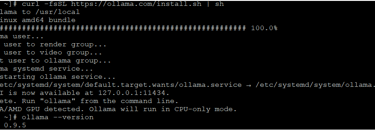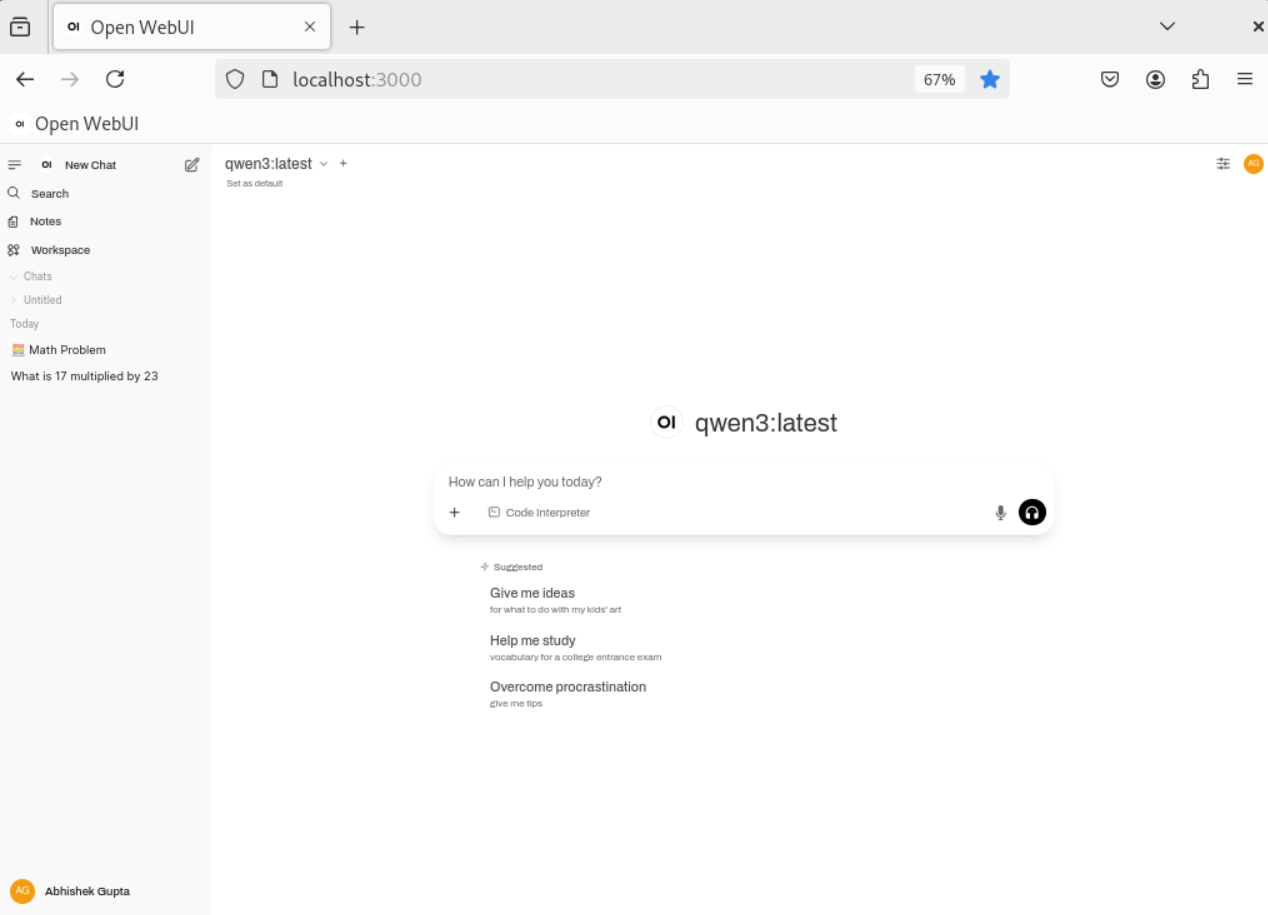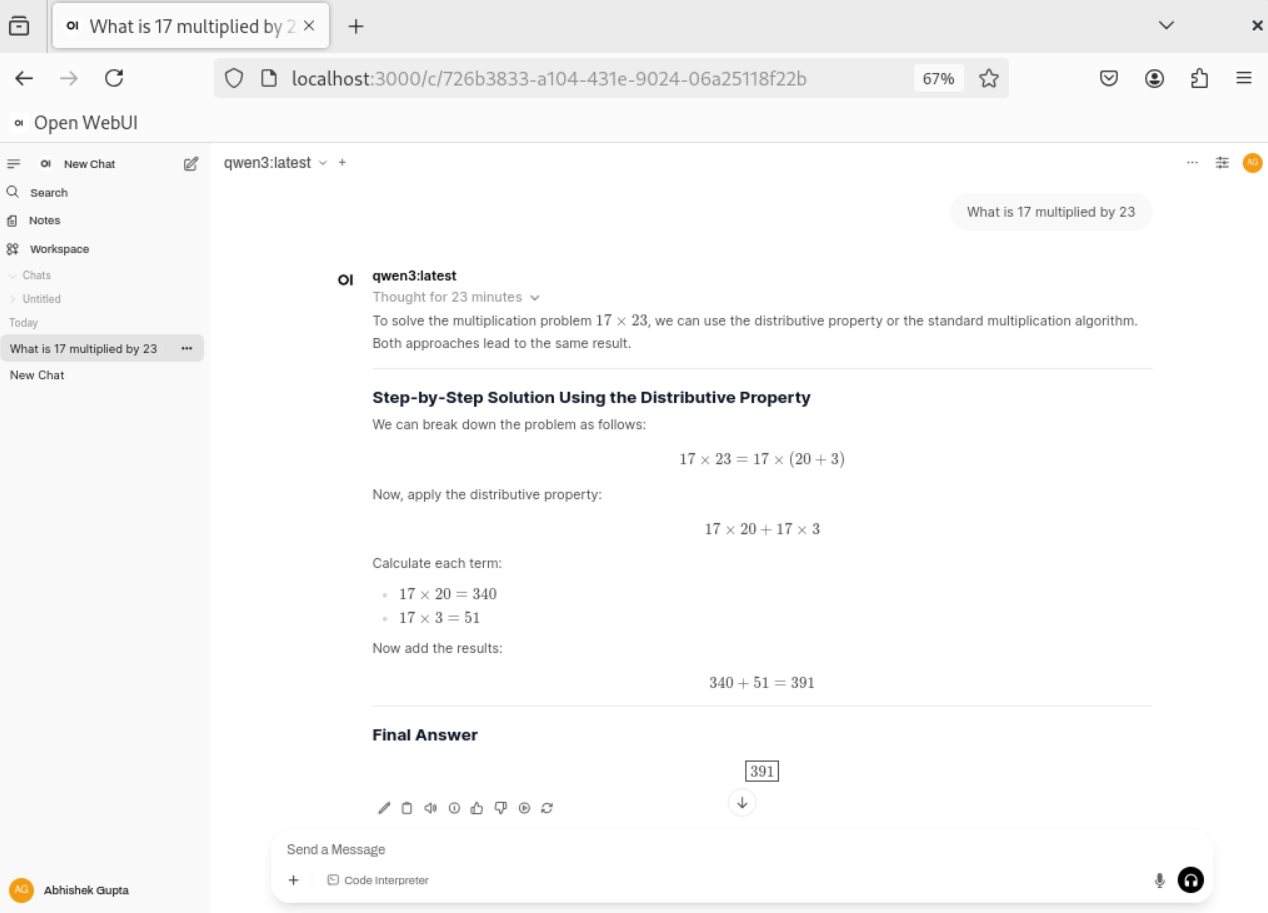Build Your Own Local Qwen 3 AI with Ollama + Open WebUI (Docker)
Learn how to set up and run the powerful Qwen 3 large language model entirely on your local RHEL 9 machine using Ollama and Docker. This step-by-step guide walks you through installing Docker, configuring Ollama, and deploying Open WebUI for a clean, browser-based chat interface. Perfect for developers and AI enthusiasts who want full control over their LLM environment—no cloud required.
ALIBABA CLOUDAIML
Abhishek Gupta
7/4/20253 min read


In this guide, you'll learn how to install and run the powerful Qwen 3 language model locally using Ollama, and interact with it through a sleek browser-based GUI powered by Open WebUI running in Docker. This setup is ideal for developers, researchers, and AI enthusiasts who want full control over their LLM environment — without relying on the cloud.
🧰 Components Overview
Qwen 3 - A powerful open-source large language model by Alibaba
Ollama - Lightweight runtime to run LLMs locally with GPU/CPU support
Docker - Container platform to isolate and run Open WebUI
Open WebUI - A modern, chat-style web interface to interact with local LLMs
🛠️ Step 1: Install Docker (on RHEL 9)
Docker is used to run Open WebUI in an isolated container.
🔧 1.1 Add Docker Repository
sudo dnf config-manager --add-repo https://download.docker.com/linux/rhel/docker-ce.repo
🔧 1.2 Install Docker Engine
sudo dnf install -y docker-ce docker-ce-cli containerd.io docker-buildx-plugin docker-compose-plugin
🔧 1.3 Start and Enable Docker
sudo systemctl start docker
sudo systemctl enable docker
🔧 1.4 (Optional) Run Docker Without sudo
sudo usermod -aG docker $USER
newgrp docker
✅ 1.5 Test Docker
docker run hello-world
🤖 Step 2: Install Ollama and Run Qwen 3
Ollama is a local LLM runtime that simplifies downloading, running, and managing models like Qwen 3.
🔧 2.1 Install Ollama
curl -fsSL https://ollama.com/install.sh | sh
🔧 2.2 Start the Ollama Service
ollama serve
This runs a local API server on port 11434.
🔧 2.3 Pull and Run Qwen 3
ollama run qwen3
This downloads the model and starts a REPL-style chat session.
🌐 Step 3: Configure Ollama to Be Accessible from Docker
By default, Ollama listens only on localhost. We need to make it accessible to Docker containers.
🔧 3.1 Edit Ollama’s systemd Service
sudo systemctl edit ollama
Add this under [Service]:
ini
[Service]
Environment="OLLAMA_HOST=0.0.0.0"
🔧 3.2 Reload and Restart Ollama
sudo systemctl daemon-reexec
sudo systemctl restart ollama
🔧 3.3 Verify It's Listening
ss -tuln | grep 11434
You should see it bound to 0.0.0.0:11434.
💬 Step 4: Run Open WebUI in Docker
Open WebUI provides a clean, chat-style interface to interact with Qwen 3.
🔧 4.1 Stop Any Existing Container (if needed)
docker stop open-webui
docker rm open-webui
🔧 4.2 Run Open WebUI with Ollama Connection
Replace <your-server-ip> with your actual IP address:
docker run -d -p 3000:8080 \
-e OLLAMA_BASE_URL=http://<your-server-ip>:11434 \
--name open-webui \
--restart always \
-v open-webui:/app/backend/data \
ghcr.io/open-webui/open-webui:main
🔧 4.3 Access the GUI
Open your browser and go to:
🧩 Step 5: Add Qwen 3 in the GUI
Go to the Admin Panel (bottom-left corner)
Click Connections
Add a new connection:
Name: Local Ollama
Base URL: http://<your-server-ip>:11434
API Key: (leave blank or use ollama)
Save and go back to the chat window
Select qwen3 from the model dropdown
🧪 Step 6: Test Qwen 3
Try a few prompts in the chat:
✅ Basic math:
What is 17 multiplied by 23?









🧠 Technical Background
🔹 Qwen 3
Qwen 3 is a family of open-source LLMs developed by Alibaba. It supports advanced reasoning, multilingual understanding, and code generation. It comes in multiple sizes (0.5B to 72B).
🔹 Ollama
Ollama is a local LLM runtime that simplifies model management. It supports GPU acceleration, streaming responses, and a REST API for integration.
🔹 Docker + Open WebUI
Docker isolates the GUI environment, making it easy to deploy and update. Open WebUI connects to Ollama via HTTP and provides a modern interface for chatting with models.
With this setup, you now have a fully local, private, and powerful AI lab running Qwen 3. You can interact with it via API or GUI, test its capabilities, and even build your own AI-powered tools on top of it.
